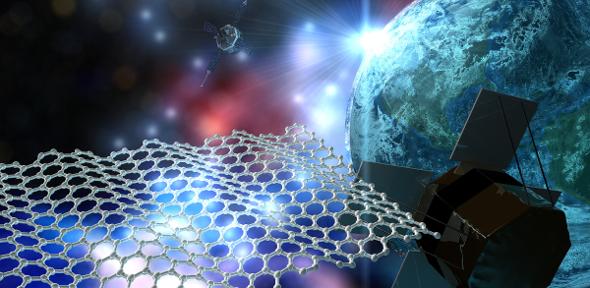
Submitted by Administrator on Tue, 25/07/2017 - 12:07
The Cambridge Graphene Centre are involved in one of two Graphene Flagship experiments testing graphene in zero-gravity conditions that will be launched in November.
Researchers and students in the Graphene Flagship are preparing for two exciting experiments in collaboration with the European Space Agency (ESA) to test the viability of graphene for space applications. Both experiments will launch between 6-17th November 2017, testing graphene in zero-gravity conditions to determine its potential in space applications including light propulsion and thermal management.
The Graphene Flagship is a pan-European research initiative dedicated to developing new technologies based on graphene, the single-atom-thick allotrope of carbon with excellent electrical, mechanical, thermal and optical properties. A fundamental aspect of the Graphene Flagship is training students and young researchers. These ambitious space-related experiments are an excellent opportunity for Flagship students and researchers to gain new experiences in cutting-edge research.
Researchers from the Cambridge Graphene Centre are involved in an experiment investigating how graphene can improve efficiency in heat transfer in loop heat pipes – cooling systems used extensively in satellites and aerospace instruments. The experiment is a collaboration between Graphene Flagship partners at the Microgravity Research Centre, Université libre de Bruxelles, Belgium; the Cambridge Graphene Centre, University of Cambridge, UK; Institute for Organic Synthesis and Photoreactivity, National Research Council of Italy (CNR), Italy; and Leonardo Spa, Italy, a global leader in aerospace, producing of a variety of components and systems for space applications.
A significant part of the loop heat pipe is the wick, typically made of porous metal. In this experiment, the wicks will be coated with different types of graphene-related materials to improve the efficiency of the heat pipe. The coated wicks will be tested in a low-gravity parabolic flight operated by ESA in partnership with Novespace, France. During each 3-hour flight, the specially modified plane will make a series of 30 parabolic ascents with around 25 seconds of weightlessness in each parabola.
Involved in the experiment are Graphene Flagship researchers Vanja Mišković and Fabio Iermano, both working at the Microgravity Research Centre, and Lucia Lombardi and Yarjan Samad, both at the Cambridge Graphene Centre. As well as the on-ground experiments, the young researchers will experience weightlessness on board the low-gravity flights in November.
“I’m really excited because this will be my first zero gravity experience,” said Lombardi. “The idea is to use graphene to improve the thermal conductivity and the capillary pressure by growing a sponge in the pores of the wicks,” she added.
“We want to test different kinds of coatings since the graphene and graphene oxide have different properties, but we are hoping to achieve good results with both of the coatings,” added Mišković. “I’m very excited, I know that not a lot of people get this opportunity.”
Andrea Ferrari (University of Cambridge), Science and Technology Officer of the Graphene Flagship and chair of its management panel added "Space is the new frontier for the Graphene Flagship. These initial experiments will test the viability of graphene-enabled devices for space applications. The combined strengths of the Graphene Flagship, Flagship partners and the European Space Agency as well global leader in aerospace applications Leonardo, give a strong basis to reach a high technology readiness level."
Jari Kinaret (Chalmers University of Technology, Sweden), Director of the Graphene Flagship, said “These two projects exemplify the two-fold character of the Graphene Flagship: the loop heat pipe project is targeting a specific application, while the light sail project is firmly linked to basic research and builds upon the unique combination of properties that only graphene can offer. I am particularly proud of the fact that one of these projects was initiated by students working on area completely disconnected from space applications: this demonstrates the creativity of the next generation of researchers, and shows the sometimes surprising links between different parts of our Flagship - or maybe I should say spaceship?”

